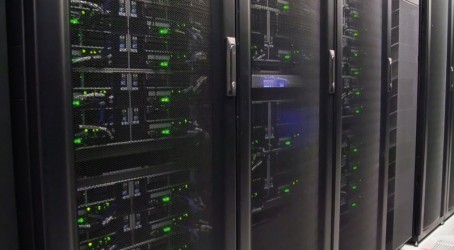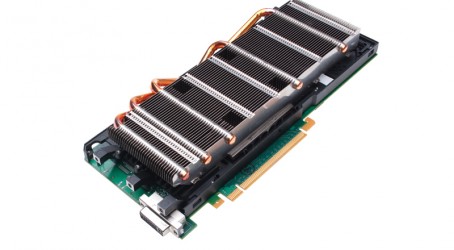The Emerald system is the jewel in the crown of university supercomputing in Britain. Developed in partnership with the universities of Oxford, Bristol, Southampton and University College London, it is said to be the most powerful graphics processing unit-accelerated (GPU) computer on these shores and is installed at the Science and Technology Facilities Council Rutherford Appleton Laboratory in Didcot, Oxfordshire.
Emerald exemplifies a trend in computing development in which GPUs are employed in tandem with CPUs to improve performance and decrease energy usage.
Powerful supercomputers such as Emerald can be used for a range of applications – wherever large amounts of data need to be crunched during the process of computationally-intensive research. So astrophysics, chemistry, life sciences, genomics and, indeed, engineering are all among areas that can benefit from them.
Mike Giles, professor of scientific computing at the University of Oxford, says Emerald is the most powerful machine of its type in UK academia, and one of the most powerful in Europe.
It was developed with the help of technology firm Nvidia, which invented the GPU 13 years ago. In fact, the academic market is an important one for the company.
Jeremy Purches, higher education and research business development manager at Nvidia, says: “We collaborate very closely with universities – it’s one of our best areas and we also work with some of the external companies, such as Jaguar Land Rover
or Rolls-Royce.
“Universities tend to be one of the first places where they can carry out some high-level research to prove that their applications work, without actually having to do it on site.”
Giles has been involved for a number of years in Rolls-Royce’s development of computational fluid dynamics (CFD) software, to simulate gas flow through a gas turbine.
He says: “One of our research projects right now is moving the main Rolls-Royce corporate CFD code, called Hydra, on to GPUs.”
GPUs were developed initially by Nvidia to satisfy consumer needs, especially those of gamers, where high-powered graphical acceleration is needed.
But some users realised that the technology could be used to provide extra processing power for high-performance computing, especially in the area of research.
GPU computing lines up GPU chips next to conventional CPUs to accelerate scientific and engineering applications, like the development of code for engineering projects. Universities played a big part in this innovation, says Purches.
“They saw that some very high-level number-crunching code could be carried out on GPUs. That’s where it started and was when Nvidia picked up on it. And we’ve not looked back. Graphics chips for gaming is still our biggest market but, even there, GPUs are increasingly being used to process the physics of a game, not just the graphics.
“GPUs can be graphics chips that don’t actually do graphics output, but do parallel processing for high-performance computing.”
The Emerald system features 372 GPUs, versus around 60 in earlier British supercomputers. “The number of GPUs is the main computing element of Emerald,” says Giles. The chips are useful because of both their speed and relatively low power consumption.
“But it’s more about the amount of processing power you get from a computer per watt of electricity,” says Purches. “Their efficiency makes GPUs particularly attractive, especially with high electricity prices. Over the three-year life of a system, power costs can equal 40% of the purchase price.”

There is likely to be further collaboration between the universities, Nvidia and industrial users as technology develops and supercomputers such as Emerald are used for new tasks.
Nvidia is currently working with the Square Kilometre Array project, a radio-telescope project, to see if it can develop hardware that suits the needs of the scientists behind the array. “That will have an impact on our future designs,” says Purches.
So what will future supercomputers be like? The GPU model is likely to remain in favour, although it’s hard to predict exactly what the next architecture will be.
“It’s clear systems are going to be massively parallel, which is the only way nowadays to deliver performance with good energy efficiency,” says Giles. “Companies like Nvidia will have to balance the needs of the market – they will need to provide what gamers require on the one hand, and what I want on the other.”
Purches says: “We have to be parallel. We cannot make anything faster than the clock rates we have, so the only way we can increase performance is to have multiple processors. We are seeing a hybrid world of GPUs and CPUs as on the Emerald today, and that is going to prove the de facto system, not only for high-performance computing, but for any large system.”

Knovel approach to knowledge
Another firm making technological inroads into universities is New York-based Knovel, which aggregates engineering content from thousands of publications and makes it available online.
Users can click on material such as graphs and equations and modify it to suit them. The information can then be shared across the world. Half of Knovel’s customer base is academic. Many engineering schools use the system, but it is also in favour with the likes of BAE Systems, Rolls-Royce and Pratt & Whitney.
Andy Brown, a former aeronautical engineer who is head of corporate sales at Knovel, says universities are keen on the technology because it helps students solve problems in the way in which they will need to do once they enter the workplace. It is also a method of learning suited to the internet generation.
He points out that learning about tools that you may have to use later in your career during university is beneficial to students. “When I was an undergraduate, you would have to search through databases for abstracts of papers and then send off to the British Library to get the papers. With Knovel you can access thousands and thousands of papers instantly.
“We were actually formed by a chemical engineer – a process engineer – who was frustrated by how long it took to find answers to engineers’ questions and to get quick solutions to problems.
“Firms need graduates who appreciate the fundamentals of engineering and physics. They need to understand the issues behind problems and be able to go out and do some research that is ultimately validated, from a trustworthy source and has been through a vetting process.
“Then I reference that material and make the right citations. It’s all things you need to do as a practising engineer before you’re allowed to sign off on a job – the very same things you should be doing in university, too.”